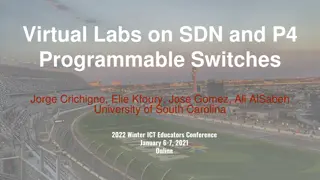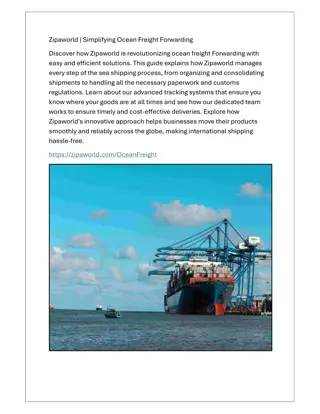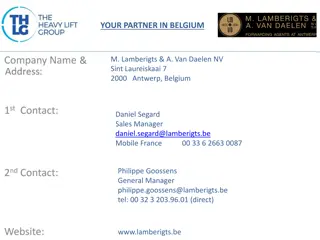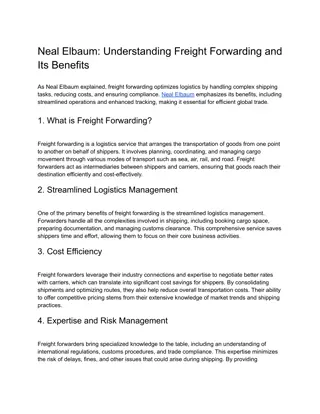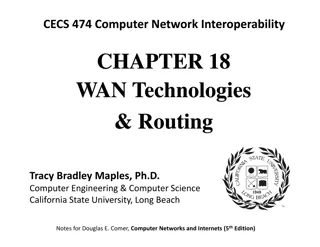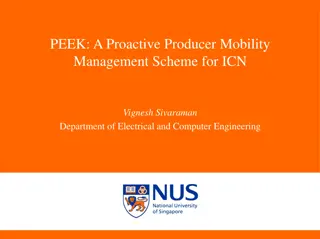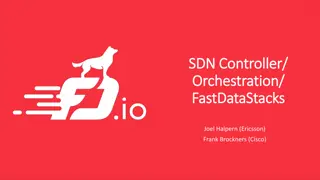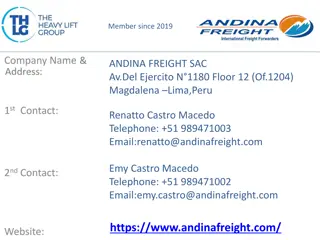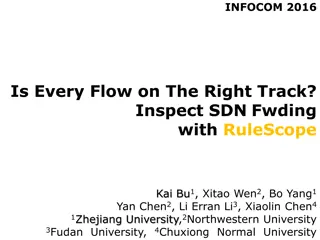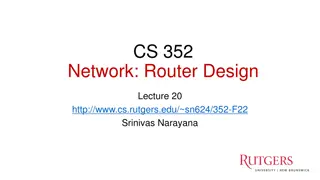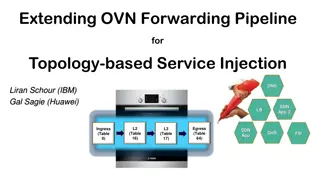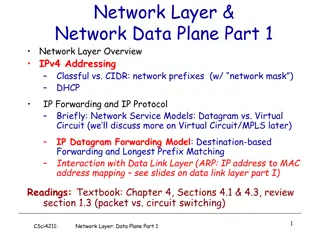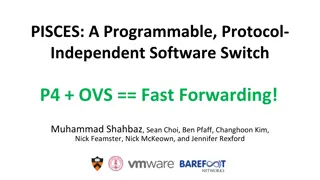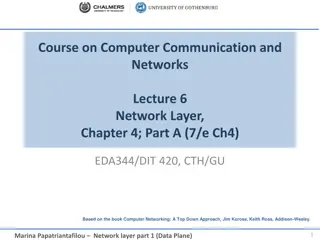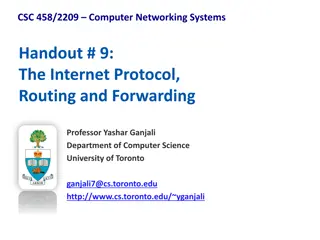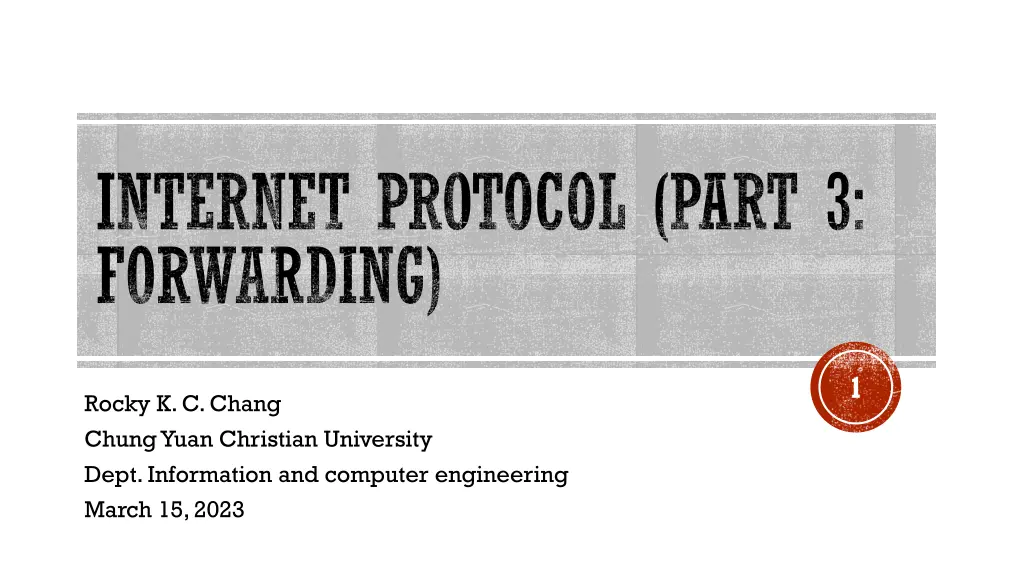
Understanding Internet Protocol Forwarding and Routing
Explore the differences between switches and routers, the intricacies of IP forwarding, and the challenges routers face in packet handling. Discover the fundamentals of forwarding, routing, and switching in IP networks.
Download Presentation

Please find below an Image/Link to download the presentation.
The content on the website is provided AS IS for your information and personal use only. It may not be sold, licensed, or shared on other websites without obtaining consent from the author. If you encounter any issues during the download, it is possible that the publisher has removed the file from their server.
You are allowed to download the files provided on this website for personal or commercial use, subject to the condition that they are used lawfully. All files are the property of their respective owners.
The content on the website is provided AS IS for your information and personal use only. It may not be sold, licensed, or shared on other websites without obtaining consent from the author.
E N D
Presentation Transcript
INTERNET PROTOCOL (PART 3: FORWARDING) 1 Rocky K. C. Chang Chung Yuan Christian University Dept. Information and computer engineering March 15, 2023
CONTENT Switches vs routers The IP forwarding problem The IP address lookup problem IP tunneling Forwarding-related ICMP messages 2
ROUTERS VS SWITCHES Price/performance comparison Besides packet forwarding, routers offer rich functionalities: Support multiple network-layer protocols. Block broadcast packets. Provide type-of-service routing (differentiated service). Perform admission control, per-flow queueing, resource reservation, and fair scheduling. Assist in network congestion control. Support tunneling Support IP fragmentation Perform NAT, etc 3
A ROUTER NEEDS TO WORRY ABOUT Integrity of an incoming packet: Checksum for the header Source address spoofing (limited) Receiving: queueing, scheduling, detunneling, etc Dropping or forwarding Dropping (TTL, broadcasting, congestion, and the integrity issues) and feedback Forwarding: destination address (and perhaps source addresses and interface), and TOS. Forwarding Fragmentation, tunneling, source address and port translation 4
FORWARDING, ROUTING, AND SWITCHING Routing: the process by which nodes exchange topological information to build correct forwarding tables. Routing protocols (OSPF, BGP, IS-IS, etc) Forwarding: the operation of deciding the next-hop address to forward to. Forwarding table vs routing table Switching: the operation of moving a packet from an input port to an output port. IP router: one that forwards IP packets for others. 6
IP ROUTING VS IP SWITCHING IP routing protocol IP routing protocol Ethernet, Token ring, FDDI, etc ATM (cell switching table) 7
THE IP FORWARDING PROBLEM Assume that both routers and hosts already have appropriate routing tables in place. Routing tables for routers are constructed from routing protocols or by hand. Routing tables for hosts are constructed from other means (to be discussed later). Problem: Given a forwarding table and an IP packet, how do hosts and routers make forwarding decisions? 8
IP FORWARDING MECHANISMS Routing protocol (router only) ICMP redirect messages (host only) Router discovery protocol (host only) Manual configuration (router and host) IP packets IP Output (compute the next hop) router only IP forwarding table Network interfaces 9
EXERCISES Display your host s routing table by netstat rn. For Unix users, you need to look up the meanings of the flags (e.g., U, G). Locate the route for the local hosts and that for the remote hosts. What is the IP address of the default router? 10
TYPES OF FORWARDING ENTRIES Unicast vs multicast destinations Loopback vs actual routes Host-specific vs network specific routes First-hop forwarding vs last-hop forwarding vs in-between forwarding The last two are for routers only. 11
FORWARDING TABLES IN HOSTS A host s view about the outside world is binary: either local or nonlocal. In the local case, it sends datagrams to the destination directly. In the nonlocal case, it sends datagrams to a default router. In both cases, the host uses ARP cache or ARP to find out the corresponding MAC addresses. 13
EXERCISES Go to https://lookingglass.centurylink.com/ and find the route to 158.132.0.0 with BGP mask of 16. How many routes to 158.132.0.0/16 do you find? 14
A SUBNET EXAMPLE Subnet mask: 255.255.255.128 Subnet number: 128.96.34.0 128.96.34.15 128.96.34.1 H1 R1 Subnet mask: 255.255.255.128 Subnet number: 128.96.34.128 128.96.34.130 128.96.34.139 128.96.34.129 H2 R2 H3 128.96.33.1 128.96.33.14 Subnet mask: 255.255.255.0 Subnet number: 128.96.33.0 15
ROUTING TABLES R1 s routing table: Network/Subnet Subnet Mask 128.96.34.0 255.255.255.128 upper int. 128.96.34.128 255.255.255.128 lower int. 128.96.33.0 255.255.255.0 Next Hop 128.96.34.129 H1 s routing table: Network/Subnet Subnet Mask 128.96.34.0 255.255.255.128 upper int. 0.0.0.0 0.0.0.0 Next Hop 128.96.34.1 16
EXERCISES Write down the routing tables for other hosts and routers in the subnet example. 17
BOOTSTRAPING FORWARDING TABLES Whenever an interface is initialized, a direct route (to a host in a point-to-point link or to a network in a LAN) is automatically created. With IP address and subnet mask configured For nonconnected networks, Hosts to find default routers: Configure manually through route command. Use ICMP router discovery protocol Use ICMP redirect Use DHCP Routers run a routing protocol (a routing daemon) to automatically discover routes. 18
CHARACTERISTICS OF IP FORWARDING Both hosts and routers are involved in forwarding. Compared with routers, a host makes a much simpler binary decision. IP forwarding is done on a hop-by-hop basis. It is assumed that the next-hop router is really closer to the destination. IP forwarding is able to specify a route to a network, and not have to specify a route to every host. 19
A UNICAST IP FORWARDING ALGORITHM D = Destination IP address for each entry (Network/Subnet ID, Subnet Mask, Next Hop) D1 = Subnet mask bitwise & D if D1 = Network/Subnet ID if Next Hop is an interface deliver datagram directly to destination else deliverdatagram to Next Hop (a router) 20
EXERCISES For the subnet example, explain how a packet is delivered from H1 to H2. For the subnet example, explain how a packet is delivered from H1 to H3. 21
THE IP ADDRESS LOOKUP PROBLEM The problem: How can a router look up a destination address in its routing table as quickly as possible? The address lookup operation is a major bottleneck in routers forwarding performance. In the classful addressing architecture Three separate tables are used for classes A, B, C addresses (the first three bits). Use hashing or binary search to look up addresses. 23
CLASSLESS INTERDOMAIN ROUTING (CIDR) CIDR is a solution to the class B address exhaustion and routing table size problems. Allocate a contiguous block of class C addresses (2, 4, 8, etc) instead of a class B address. To reduce the increase in routing table size, interdomain routing needs to perform route aggregation. With CIDR, the service provider can aggregate the classful networks into a single classless advertisement. 24
CIDR EXAMPLES Inter-domain routing without CIDR 208.12.16.0 208.12.16.0 Service provider A 208.12.17.0 208.12.17.0 : : : 208.12.31.0 208.12.31.0 Inter-domain routing with CIDR 208.12.16.0 Service provider A 208.12.16.0/20 208.12.17.0 : : 208.12.31.0 25
PREFIX OVERLAPPING In CIDR, a packet may match to multiple routing entries (prefix overlap), e.g., Addresses 208.12.16.0/24 to 208.12.31.0/24 are aggregated into 208.12.16.0/20. Later on, the network with address 208.12.21.0/24 changed its ISP but does not want to renumber. Now the previous addresses cannot be aggregated into a single route to 208.12.16.0/20. 26
PREFIX OVERLAPPING 208.12.16.0 Service provider A 208.12.16.0/20 ? 208.12.17.0 : : 208.12.21.0 Service provider B 208.12.21/24 : 208.12.31.0 27
PREFIX OVERLAPPING Solution: Retain the route 208.12.16.0/20 and add a separate route to 208.12.21.0/24. The latter route is known as an exception to 208.12.16.0/20. Use longest prefix match to forward packets to 208.12.21.0/24. Longest prefix matching algorithms 28
DIFFICULTY WITH THE CLASSLESS ADDRESSING Reducing forwarding table size more complex IP address lookup The destination prefixes have arbitrary lengths (instead of 3 lengths). The length of the prefix cannot be derived from the destination address in the IP header. Searching in two dimensions: the prefix length and value 29
A CLASSIC SOLUTION BASED ON BINARY TRIES A binary trie is used to represent a set of prefixes, e.g., node a: 0 , node c: 011 , and node i: 1111 The shaded nodes are the prefixes that are stored in the router s forwarding table. Nodes c and b represent exceptions to prefix 0 (node a). Given a destination address, Traverse the tree according to the bits in the address and remember the last prefix visited. End when there are no more branches to take. 30
A BINARY TRIE 0 1 a d 1 0 1 0 1 1 0 0 c e 0 0 1 0 1 f g h i 0 b 31
A BINARY TRIE For example, the best matching prefix (BMP) for an address starting with 10110 is prefix d (1). Updating a binary trie is simple: Traverse the tree until there is no path to take; then insert the node. Sequential prefix search by length Effective if the prefixes are densely populated. 32
PATH-COMPRESSED TRIES Key observations: A branch of one-child nodes in a binary trie does not help reducing the search space. One-child nodes consume additional memory. Approach: Collapse the branches of one-child nodes. Additional information stored in the one-child nodes need to be retained in the remaining nodes. 33
PATH-COMPRESSED TRIES 1 0 1 3 2 a d 0 1 0 1 3 b c e 1 0 4 4 0 1 0 1 f g h i 34
PATH-COMPRESSED TRIES Node changes: The two one-child nodes above b, and the one above e are removed. Node a, being a one-child node, moves down to the place of its child. New nodal information: A number indicating which bit to be examined next. The prefixes must be explicitly stored. The search algorithm similar to before. 35
PATH-COMPRESSED TRIES For example, a prefix starting with 010110 Examining the first bit and take the left path Compare the prefix value stored in a (0) with 010110, and remember the prefix value. Examine the third bit and take the left path. Compare the prefix value stored in b (01000) and do not match. Therefore, the BMP = 0. The path compression is useful if the prefixes are sparsely populated. 36
EXERCISE 37
PACKET CLASSIFICATION Routers today are often required to classify individual packets into flows. A flow is defined by a set of values in the IP header fields, such as addresses, ports, transport protocols. For the purpose of accounting, traffic shaping, filtering policies, per-flow queueing, etc. In general, incoming packets are subject to a classifier that consists a number of rules (with priority). 38
A PACKET CLASSIFIER EXAMPLE Rule IP dest. addr. IP src. addr. Dest port Trans- port prot * Action R1 152.163.190.69/ 255.255.255.255 152.163.80.11/ 255.255.255.255 * Deny R2 152.168.3.0/ 255.255.255.0 152.163.200.157/ 255.255.255.255 Eq www udp Deny R5 152.163.198.4/ 255.255.255.255 152.163.160.0/ 255.255.252.0 gt 1023 tcp Permit R6 0.0.0.0/0.0.0.0 0.0.0.0/0.0.0.0 * * Permit
A PACKET CLASSIFIER EXAMPLE Packet header IP dest. Addr. IP src. Addr. Dest port Trans- port prot Action P1 152.163.190.69 152.163.80.11 www tcp R1, deny P2 152.168.3.21 152.163.200.157 www udp R2, deny P3 152.163.198.4 152.163.160.10 1024 tcp R5, permit 40
THE PACKET CLASSIFICATION PROBLEM Problem: How to classify packets that can meet a number of requirements, such as the speed, storage, scalability, etc. Longest prefix matching for IP table lookup is a special case of 1- dim. packet classification. The length of the prefix defines the priority of the rule. 41
AN EXAMPLE (F1 AND F2 COULD BE ADDRESSES) 42 Rule F1 F2 R1 00* 00* R2 0* 01* R3 1* 0* R4 00* 0* R5 0* 1* R6 * 1* 42
A GEOMETRIC REPRESENTATION OF THE CLASSIFER 43
A D-DIMENSIONAL HIERARCHICAL RADIX TRIE 0 1 F1-trie 0 1 0 1 0 0 F2-tries 1 R3 0 R6 R5 R4 R2 R1 44
A D-DIMENSIONAL HIERARCHICAL RADIX TRIE Classification algorithm: First traverse the F1-trie based on the bits corresponding to F1. Follow the next-trie pointers if present, and traverse the (d-1)-dim. trie. For example, an incoming packet with (000, 010) It matches both R2 and R4. 45
IP TUNNELS 46
IP TUNNELS There are quite a few situations that require two network nodes (hosts or routers) to tunnel IP datagrams between them. IP network a b A packet destined to node d [src = a, dest = b][original IP packet] The original packet 47
IP TUNNELS The two tunnel endpoints need to configure the tunnel states before tunneling packets. The two endpoints treat the tunnel as another (logical) data-link with a new MTU value (tunnel MTU). The sending side performs IP-in-IP encapsulation (or other encapsulation) and then the regular IP forwarding. The receiving side performs the corresponding decapsulation and may continue forwarding the packet if it is not the final destination. Other routers on the path forward the tunneled packets as any other packets. Multiple tunnels may be used between a source and a destination. Concatenation of several IP tunnels Nesting of IP tunnels 48
FOR EXAMPLE, 49 LAN B LAN C LAN D LAN A R2 R3 R1 R4 MTU1 MTU2 MTU3 MTU4 PMTU2,3 = Path MTU from R2 ro R3 min{MTU1, MTU4, min{MTU2, MTU3, PMTU2,3 20} 20} or min{MTU1, MTU2 20, MTU3 20, PMTU2,3 40, MTU4}. 49
EXERCISE Download gre_and_4over6.cap from i-Learning. How many headers are found in the first packet? How many tunnels did this packet go through? What kinds of tunnels were used? 50

